![]()
![]()
![]()
Use LEFT and RIGHT arrow keys to navigate between flashcards;
Use UP and DOWN arrow keys to flip the card;
H to show hint;
A reads text to speech;
100 Cards in this Set
- Front
- Back
|
In comparing polysulfide, polyether and
addition cured silicone impression materials, which of the following statements is true? A. All three of the materials contract slightly during curing. B. All the materials expand slightly upon cooling from mouth temperature (37 degrees C) to room temperature (20 degrees C). C. After one week, addition cured silicones will undergo more distortion than polysulfides. D. Lead oxide is used as an activator in silicones. |
A
|
|
|
In minimizing the firing shrinkage of
porcelain, the principal factor is the A. fusion temperature. B. ratio of flux to feldspar. C. uniformity of particle size. D. thoroughness of condensation. |
D
|
|
|
Which of the following physical properties
would be_least_important for an impression material for partially edentulous patients? A. Biocompatibility. B. Dimensional stability. C. Ease of manipulation. D. Adhesion to calcium. E. Elasticity. |
D
|
|
|
A removable partial denture is preferable to a
fixed bridge when the A. edentulous areas are large. B. abutment teeth have large undercuts. C. abutment teeth are rotated. D. residual ridges are severely resorbed. E. abutment teeth are tipped. |
A
|
|
|
To ensure the greatest accuracy, rubber base
impressions should be poured A. within 10 minutes. B. within 1 hour. C. within 8 hours. D. after 24 hours. |
B
|
|
|
Improper temporary coverage of bridge
abutments can cause A. increased tooth sensitivity. B. gingival recession. C. tooth migration. D. occlusal prematurities. E. All of the above. . |
E
|
|
|
During the fabrication of new complete
dentures, which of the following can be modified to achieve the desired occlusion? 1. The compensating curve. 2. The orientation of the occlusal plane. 3. The cusp inclination. 4. The condylar inclination. A. (1) (2) (3) B. (1) and (3) C. (2) and (4) D. (4) only E. All of the above. . |
A
|
|
|
At his first post insertion appointment, a
patient with a new removable partial denture complains of a tender abutment tooth. The most likely cause is A. overextended borders of the partial. B. inadequate polishing of the framework. C. improper path of insertion. D. the occlusion |
D
|
|
|
The contour of an occlusal rest area should be
A. angular and box shaped with precision type vertical walls. B. rounded and spoon shaped in general outline. C. flat and forming an obtuse angle to the proximal surface of the tooth. D. None of the above. |
B
|
|
|
The polymerization of methyl methacrylate is
A. endothermic. B. hydrophilic. C. hydrolytic. D. exothermic. |
D
|
|
|
Alginate hydrocolloids
A. shrink when stored in air. B. show syneresis. C. expand when stored in water. D. All of the above. |
D
|
|
|
Silicone impression materials that set by
condensation polymerization A. liberate ethyl alcohol as a byproduct of the polymerization reaction. B. polymerize more slowly. C. undergo high shrinkage during the first 24 hours. D. contain an accelerator consisting of a stannous sulfate. |
A
|
|
|
Patients with new dentures should be
instructed to 1. clean dentures over a bowl of water. 2. hold dentures properly when cleaning. 3. correct minor soreness by filing dentures. 4. persist with soreness for one week, then return for an appointment. A. (1) (2) (3) B. (1) (2) (4) C. (1) and (2) D. (2) and (4) E. All of the above. |
C
|
|
|
Which of the following problems of a permanent fixed bridge, detected at the delivery appointment, can be caused by an inadequate temporary restoration?
1. Hypersensitivity of the abutments that decreases after permanent luting. 2. Exposed gingival margins in an esthetic area. 3. Contacts with adjacent teeth that prevent complete seating of the bridge. 4. Need for significant occlusal adjustment. A. (1) (2) (3) B. (1) and (3) C. (2) and (4) D. (4) only E. All of the above. |
E
|
|
|
Gold casting alloys are classified as Type I-IV according to which of the following physical properties?
A. Percentage of gold present in the alloy. B. Surface hardness. C. Melting point. D. Elastic strength. E. Ductility. |
B
|
|
|
Prior to cementing an onlay in a vital tooth
using polycarboxylate cement, the tooth may be coated with cavity varnish A. to protect the pulp. B. to improve seal. C. to prevent post-operative sensitivity. D. None of the above. |
D
|
|
|
In cementing a full crown, it is desirable to
A. retard the set of the cement. B. apply continuous occlusal loading. C. have excess cement covering the margins. D. All of the abov |
D
|
|
|
The prime advantage of vacuum firing of porcelain is
A. better colour. B. less shrinkage. C. more translucency. D. increased strength |
C!
|
|
|
Heat treatment alters a gold alloy's
A. hardness. B. proportional limit. C. percentage elongation. D. All of the above |
D
|
|
|
Immediately prior to cementation of a fixed
bridge, it is important to check A. occlusal relationships. B. firmness and location of contact points. C. pressure of pontics against soft tissues. D. All of the above. |
D
|
|
|
A circumferential clasp arm on a tooth is one
which A. originates above the height of contour. B. approaches the undercut from an occlusal direction. C. traverses a portion of the suprabulge of the tooth. D. All of the above. |
D
|
|
|
Impressions made with thiokol (polysulfide)
rubber may be A. silver plated. B. copper plated. C. poured directly in die stone. D. All of the above. |
D
|
|
|
The microorganism most commonly associated
with root surface caries is A. Actinomyces viscosus. B. Streptococcus mutans. C. Streptococcus salivarius. D. Lactobacillus acidophilus. |
A
|
|
|
Using pins to retain amalgam restorations
increases the risk of 1. cracks in the teeth. 2. pulp exposures. 3. thermal sensitivity. 4. periodontal ligament invasion. A. (1) (2) (3) B. (1) and (3) C. (2) and (4) D. (4) only E. All of the above |
E
|
|
|
The use of cavity varnish under an amalgam
restoration will 1. have a bactericidal effect. 2. decrease marginal leakage. 3. stimulate secondary dentine formation. 4. decrease tooth discolouration. A. (1) (2) (3) B. (1) and (3) C. (2) and (4) D. (4) only E. All of the above. . |
C
|
|
|
If an impression were taken with a mercaptan rubber base material of teeth exhibiting severe external undercuts a stone model should be poured
A. immediately. B. after 30 minutes. C. after 24 hours. D. None of the above |
B
|
|
|
Prevention of gingival irritation by a major
connector of a removable partial denture is accomplished by A. using split palatal bars. B. reducing the size of the connector. C. ensuring maximum distribution of occlusal forces. D. providing relief between the connector and the gingiva. |
D
|
|
|
Following orthodontic alignment , relapse of the mandibular incisors cannot
A. Be predicted from characteristics of the original malocclusion. B. Occur if the second or third molars are removed. C. Occur if retainers are worn until the mandibular growth is complete D. Occur if a supracrestal fiberotomy is performed. |
A
|
|
|
Propylthiouracil is a drug used in the
treatment of A. leukemia. B. hyperthyroidism. C. sodium retention. D. intestinal parasites. E. allergic manifestations |
B
|
|
|
Which of the following modifications to the
standard procedure for mixing gypsum products will increase the compressive strength of the set material? A. Adding a small amount of salt to the water before mixing. B. Decreasing the water/powder ratio by a small amount. C. Using warmer water. D. Decreasing the mixing time. |
B
|
|
|
Indirect retention is NOT required for a
removable partial denture which has A. a unilateral distal extension base. B. bilateral distal extension bases. C. complete tooth support. D. an anterior extension base. |
C
|
|
|
Reduction of free-way space in complete
denture construction will 1. impair aesthetics. 2. cause the dentures to click. 3. traumatize the underlying supporting tissues. 4. induce generalized soreness over the ridges. A. (1) and (2) B. (1) and (4) C. (2) and (3) D. (2) and (4) E. All of the above. . |
E
|
|
|
In complete denture construction, a custom
tray should be selected so that the impression will ascertain that A. the flanges are not overextended. B. the distal extension is adequate. C. there is relief for muscle attachments. D. the tray has adequate space for the impression material. E. All of the above |
E
|
|
|
Longer trituration of alloy and mercury will
result in an amalgam restoration which will have A. greater expansion during setting. B. reduced strength. C. increased flow. D. None of the above. . |
D!
|
|
|
Which permanent teeth will normally be
present in an 8-year old child? A. Maxillary and mandibular central and lateral incisors. B. Mandibular central and lateral incisors and first molars. C. All central and lateral incisors and first molars. D. All central and lateral incisors, first molars and first premolars. |
C
|
|
|
A 9-year old boy sustains a fracture of the
crown of his central incisor with minimal pulp exposure. He is brought to your office within one hour of the injury. A periapical radiograph reveals that the root of the tooth is complete but the apex is open. You would A. pulp cap with calcium hydroxide and restore. B. perform a pulpotomy and seal temporarily. C. perform a pulpectomy and seal temporarily. D. perform a pulpectomy and fill immediately with gutta-percha and restore. |
A (because less then 2 h)
|
|
|
In cephalometric analysis of children with
malocclusion, the angle ANB is frequently used. In patients with severe Class~II malocclusion, this angle is A. greater than the normal. B. less than the normal. C. normal. D. unrelated |
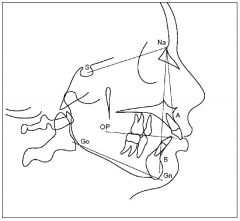
A ( maxilla protruded)
|
|
|
A skeletal cross-bite, as contrasted with
functional cross-bite, usually demonstrates A. marked wear facets. B. interference free closure to centric occlusion. C. deviated closure to centric occlusion. D. None of the above |
B
|
|
|
Which of the following malocclusions is most
commonly associated with mouth breathing? A. Class I. B. Class II, Division 1. C. Class II, Division 2. D. Class III |

B
|
|
|
Which of the following conditions should
NOT commonly be treated during the mixed dentition stage? A Anterior cross-bite. B Posterior cross-bite. C Maxillary incisor rotation. D Class II molar relationship. |
C
|
|
|
Angle used the term "subdivision" to refer to a
malocclusion in which the abnormal molar relationship was A. bilateral. B. unilateral. C. only mildly abnormal. D. severely abnormal. E. coupled with labioversion of the maxillary incisors. |
B
|
|
|
Serial extraction may result in
A. development of a closed bite. B. mandibular incisors tipping lingually. C. persistent spacing at extraction sites. D. canines tipping distally and second premolars tipping mesially. E. All of the above |
E
|
|
|
Following orthodontic rotation of teeth, which
of the periodontal ligament fibres are most commonly associated with relapse? A. Oblique. B. Diagonal. C. Horizontal. D. Supracrestal |
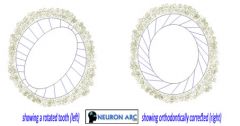
D
|
|
|
In acutely inflamed gingival tissue, there is an
increase in the A. number of mast cells. B. number of plasma cells. C. level of histamine. D. A. and B. E. A. and C. . |
E
|
|
|
In clinical dentistry, stiffness of wire is a
function of A. length of the wire segment. B. diameter of the wire segment. C. alloy composition. D. All of the above. E. None of the above. |
D
|
|
|
The accuracy of alginate impression materials
will be improved if A. the space between the tray and the teeth is 1-2mm. B. the space between the tray and the teeth allows 4-5mm of alginate. C. the impression is removed slowly from the undercuts around the teeth. D. the impression is soaked in water for 1 hour |
B
|
|
|
Compared to unfilled resins, composite resins have
1. reduced thermal dimensional changes. 2. increased strength. 3. reduced polymerization shrinkage. 4. better polishability. A. (1) (2) (3) B. (1) and (3) C. (2) and (4) D. (4) only E. All of the above. |
A
|
|
|
Premature loss of a primary maxillary second
molar usually produces a malocclusion in the permanent dentition that is characterized by A. anterior crowding. B. labially displaced maxillary canines. C. delayed eruption of the permanent first molar. D. a Class II molar relationship on the affected side. E. a Class III molar relationship on the affected side |
D
|
|
|
An anterior cross-bite of a permanent
maxillary incisor in a mixed dentition is often associated with A. a functional shift. B. unexplainable genetic factors. C. lingually situated supernumerary teeth. D. prolonged retention of a primary incisor. E. premature eruption of a maxillary incisor |
D
|
|
|
Excessive orthodontic force used to move a
tooth may 1. cause hyalinization. 2. cause root resorption. 3. crush the periodontal ligament. 4. impair tooth movement. A. (1) (2) (3) B. (1) and (3) C. (2) and (4) D. (4) only E. All of the above. . |
E
|
|
|
A unilateral cross-bite involving the permanent maxillary first molar may be
A. associated with a mandibular shift. B. a bilateral constriction of the maxilla. C. corrected with palatal expansion. D. All of the above. E. None of the above. |
D
|
|
|
A 10 year old boy has an Angle Class III molar relationship and an incisor cross-bite when in centric occlusion. When his jaws are guided to a centric relation, the molar relationship is Class I and the incisors are edge-to-edge. You should advise the parent that
A. the child has a growth problem and occlusal correction will not be completed until growth is complete. B. if the molar relationship is corrected now, future growth will likely undo the correction. C. the incisor malrelationship should be corrected now. D. future growth is likely to correct this problem. |
C (because of crossbite)
|
|
|
Cultures made from a dental abscess indicate
the infection is caused by beta hemolytic streptococcus. Which of the following is the drug of choice? A. Penicillin. B. Erythromycin. C. Tetracycline. D. Cloxacillin. |
A
|
|
|
Acid etching of dentin with 10-15% phosphoric
acid for 15-20 seconds 1. removes the smear layer. 2. increases dentinal permeability. 3. opens the dentinal tubules. 4. decalcifies the intertubular and peritubular dentin. A. (1) (2) (3) B. (1) and (3) C. (2) and (4) D. (4) only E. All of the above. |
E
|
|
|
For which of the following teeth is the risk of
root fracture increased if a rotational force is used during extraction? A. Upper canine. B. Lower canine. C. Upper first bicuspid. D. Lower first bicuspid. E. Upper lateral incisor. |
C
|
|
|
A lateral cephalometric radiograph for a
patient with a 3mm anterior functional shift should be taken with the patient in A. maximum intercuspation. B. initial contact. C. normal rest position. D. maximum opening. E. protrusive position. . |
B!
|
|
|
A 12-year old male with a history of
thumbsucking has an Angle Class II molar relationship with a SNA = 83° and a SNB = 79°. The etiology of this patient's malocclusion is A. dental. B. skeletal. C. neuromuscular. D. dental and neuromuscular. E. skeletal and neuromuscular |
SNB 79 + - 3 normal
SNA 82 +- 3 normal A? |
|
|
A patient complains of sensitivity the day
following placement of a conservative posterior composite resin restoration. The most probable cause is A. acid etching. B. microleakage. C. unpolymerized resin. D. prolonged application of the curing light. E. inadequate base thickness |
B
|
|
|
Following root planing, a patient experiences
thermal sensitivity. This pain is associated with which of the following? A. Golgi receptor. B. Free nerve endings. C. Odontoblastic processes. D. Cementoblasts |
C
|
|
|
Which of the following structures may be
associated with the role of the central nervous system in sleep (nocturnal) bruxism? A. Basal ganglia (nigrostriatal). B. A delta and C nerves. C. Sphenopalatine ganglion. D. Petrous nerves. . |
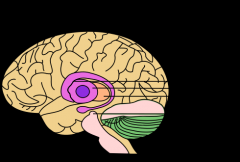
A
|
|
|
Which of the following would maximize
vitamin E intake following osseous surgery? A. Lettuce. B. Wheat germ. C. Eggs. D. Fish. |
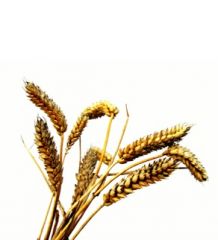
B
|
|
|
If a person falls from a bicycle, striking the
chin, the most likely region(s) of the mandible to fracture is/are: 1. Symphysis. 2. Condylar necks. 3. Mid-body. 4. Angles of the mandible. A. (1) (2) (3) B. (1) and (3) C. (2) and (4) D. (4) only E. All of the above |
С
|
|
|
The antibiotic of choice for a periapical
dental abscess is A. pen V. B. cephalosporin. C. erythromycin. D. metronidazole. E. ampicillin. |
A
|
|
|
Which of the following impression materials
has the best dimensional stability? A. Polysulfide rubber. B. Condensation silicone. C. Polyvinylsiloxane. D. Irreversible hydrocolloid. |
C
|
|
|
The incidence of tooth loss due to periodontal
disease is highest for A. maxillary molars. B. maxillary premolars. C. mandibular incisors. D. mandibular premolars. E. mandibular molars |
A
|
|
|
A patient presents with a 3 week history of prolonged tooth pain to hot and cold. Three days ago the symptoms changed to moderate pain on biting combined with a dull, spontaneous ache relieved by cold. The most likely diagnosis is
A. chronic apical abscess. B. a cracked tooth. C. pulpal necrosis. D. reversible pulpitis. E. a vertical root fracture. |
C
|
|
|
For a 20 year old, 80kg, patient with a
confirmed allergy to codeine, which of the following is/are appropriate for pain control following the removal of an impacted third molar? 1. Hydromorphone, 2mg every 4 - 6 hours p.r.n. 2. Ibuprofen, 800mg 1 hour preoperatively followed by 400mg every 4 - 6 hours p.r.n. 3. Acetaminophen, 650mg with oxycodone, 10mg every 4 - 6 hours p.r.n. 4. Ketorolac, 10mg every 4 - 6 hours p.r.n. A. (1) (2) (3) B. (1) and (3) C. (2) and (4) D. (4) only E. All of the above |
C
because codeine, hydromorphone and oxycodone resemble morphine |
|
|
Root caries risk in adults is
1. associated with previous enamel caries experience. 2. reduced in communities with fluoridated water. 3. greater in adults who have high streptococcus mutans counts. 4. similar in institutionalized and noninstitutionalized patients. A. (1) (2) (3) B. (1) and (3) C. (2) and (4) D. (4) only E. All of the above. |
A
non-institutionalized have more root caries |
|
|
Normal aging changes in the hard tooth
tissues include 1. continuous deposition of cementum. 2. continuous deposition of dentin. 3. decreased blood supply to the pulp. 4. increased porosity of enamel. A. (1) (2) (3) B. (1) and (3) C. (2) and (4) D. (4) only E. All of the above |
A
|
|
|
Epstein-Barr virus is associated with which of
the following? 1. Shingles. 2. Oral hairy leukoplakia. 3. Chickenpox. 4. Infectious mononucleosis. A. (1) (2) (3) B. (1) and (3) C. (2) and (4) D. (4) only E. All of the above |
C
|
|
|
A mandibular fracture during normal
mastication is most likely to occur in a patient with A. osteoporosis. B. a large intraosseous lesion. C. an impacted tooth at the inferior border. D. advanced alveolar atrophy. |
B
|
|
|
Which of the following factors influence(s)
the development of root caries? 1. A diet high in refined carbohydrates. 2. Periodontal disease. 3. The anatomy of the cemento-enamel junction. 4. Xerostomia. A. (1) (2) (3) B. (1) and (3) C. (2) and (4) D. (4) only E. All of the above. . |
E
|
|
|
The average annual dose of ionizing radiation
that a patient receives from dental radiographs is A. greater than the average amount received from natural sources. B. about the same as the average amount received from medical sources. C. about the same as the average amount received from cosmic radiation. D. low when compared to the average total amount of radiation received.. |
D
|
|
|
Which procedure(s) require(s) antibiotic
prophylaxis in a patient susceptible to bacterial endocarditis? 1. Impressions for partial dentures. 2. Suture removal. 3. Mandibular block anesthetic injection. 4. Periodontal surgery. A. (1) (2) (3) B. (1) and (3) C. (2) and (4) D. (4) only E. All of the above. |
C!
new guidelines 2007 |
|
|
A large, deeply furrowed tongue is commonly
found in patients with A. Pierre Robin Syndrome. B. geographic tongue. C. ectodermal dysplasia. D. Down’s Syndrome. |
D
|
|
|
A recommended method for disinfecting
alginate impressions is to immerse the impression for 10 minutes in A. a complex phenolic. B. 2% glutaraldehyde. C. 10% ethyl alcohol. D. a 1:10 dilution of sodium hypochlorite |
B
|
|
|
Cephalosporin antibiotics
1. may be cross-allergenic with penicillin. 2. have a narrower spectrum than penicillin. 3. have a mechanism of action similar to that of penicillin. 4. may cause cholestatic hepatitis. A. (1) (2) (3) B. (1) and (3) C. (2) and (4) D. (4) only E. All of the above. |
B
|
|
|
In an infrabony periodontal pocket, the tip
of the periodontal probe is located A. at the cemento-enamel junction. B. at the level of the alveolar crest. C. between the gingival margin and the functional epithelium. D. apical to the level of the alveolar crest. |
D
|
|
|
Crusted hemorrhagic and ulcerative lesions of the lips in a patient with target-like skin lesions are typical of
A. lupus erythematosus. B. Reiter’s syndrome. C. Behçet’s syndrome. D. erythema multiforme. E. pemphigus vulgaris. |

D
|
|
|
After setting, alginate impressions
A. absorb water. B. remain dimensionally stable for 12 hours. C. have higher tear strength than polyvinylsiloxane impressions. D. can be poured twice with little effect on accuracy of the resulting cast. |
A
|
|
|
Root planing is used in the treatment of
pockets which are 1. edematous. 2. fibrotic. 3. below the mucogingival junction. 4. infrabony. A. (1) (2) (3) B. (1) (2) (4) C. (2) and (3) D. All of the above |
D
|
|
|
A 9 year old boy sustains a fracture of the
crown of his central incisor with minimal pulp exposure. The accident occurred one hour prior. A periapical radiograph reveals that the root of the tooth is intact but the apex is open. The most appropriate treatment is to A. pulp cap with calcium hydroxide and restore. B. perform a pulpotomy and seal temporarily. C. perform a pulpectomy and seal temporarily. D. perform a pulpectomy and fill immediately with gutta-percha and restore. |
A
|
|
|
Which of the following cells are characteristic
of chronic inflammation of the dental pulp? 1. Plasma cells. 2. Macrophages. 3. Lymphocytes. 4. Neutrophils. A. (1) (2) (3) B. (1) and (3) C. (2) and (4) D. (4) only E. All of the above. . |
A
|
|
|
The extraction of a maxillary deciduous
central incisor at the age of 6 years will cause A. loss of intercanine space. B. increased intercanine space. C. no change in intercanine space. D. decreased overjet. . |
C
|
|
|
Cleft lip and palate usually result from
A. failure of proper union of the median and lateral nasal processes. B. failure of the union of the median nasal process with the lateral nasal and maxillary processes. C. anhidrotic ectodermal dysplasia. D. failure of development of both the lateral nasal and maxillary processes. |

B
|
|
|
Which of the following will result in splitting of developing roots?
A. Epithelial diaphragm forms too many lateromedial extensions. B. Dental follicle cells migrate into the epithelial diaphragm. C. Cementoblasts fail to develop on and stabilize the root’s surface. D. Periodontal ligament forms too soon |
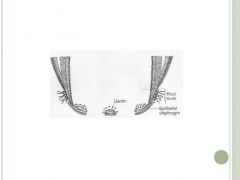
A
|
|
|
Polymerization shrinkage associated with the
setting of composite resins is a result of A. primary bonds replacing secondary bonds. B. reaction by-products evaporating from the set material. C. unreacted monomer evaporating from the set material. D. temperature changes occurring during the polymerization reaction |
A. Cure shrinkage is an inherent property of polymerizing
systems due to the conversion of secondary bonds between monomer (or prepolymer) molecules to primary bonds, which have smaller interatomic distances. Cure shrinkage is highly undesirable: it impairs dimensional control and causes poor surface finish in molded polymers; it also generates setting stresses in highly filled systems. |
|
|
In polyalkenoic cements Tartaric acid role is of:
A. Initiator B. Retarder C. Activator D. Accelerator E. Catalyst |
D
|
|
|
To ensure a clinically acceptable setting time, polyalkenoic cements contain
A. salicylic acid. B. phosphoric acid. C. maleic acid. D. tartaric acid. E. itaconic acid. |
D
|
|
|
A 75 year old male patient whose wife died
10 months ago presents for his recall appointment. Looking wasted and fatigued, he confirms he has lost about 6kg in the last 8 months but is otherwise in good health. The most appropriate management for this patient is to A. recommend that he drink 3 cans of a nutritional supplement each day. B. refer him to a qualified dietician/nutritionist and follow up after his appointment. C. refer him back to his physician requesting a more thorough assessment. D. provide him with a copy of Canada’s Food Guide to Healthy Eating |
C
|
|
|
Increasing the kVp results in
A. increased long scale image contrast. B. increased short scale image contrast. C. decreased long scale image contrast. D. decreased short scale image contrast. |
A
|
|
|
Which anatomical structures form the
inverted Y (Y line) in maxillary periapical radiographs? A. Nasopalatine/incisive canal and floor of the nasal fossa. B. Anterior nasal spine and nasopalatine/incisive canal. C. Floor of the nasal fossa and maxillary sinus border. D. Zygomatic process of the maxilla and maxillary sinus border. |
C
|
|
|
Which of the following has the greatest effect
on the mechanical properties of composite resin? A. Modulus of elasticity of the filler particles. B. Weight fraction of the filler particles. C. Volume fraction of filler particles. D. Hardness of filler particles. E. Size of the filler particles. |
C
|
|
|
Which of the following maxillary incisor angulations complicates a functional appliance construction bite?
A. Retroclined central incisors. B. Proclined lateral incisors. C. Retroclined lateral incisors. D. Proclined central incisors. |
A
|
|
|
The most practical method to significantly
reduce the setting time of stone and plaster is to use A. warm mixing water. B. a calcium sulfate dihydrate nucleating agent. C. a sodium sulfate nucleating agent. D. a longer mixing time. |
B
|
|
|
A patient with a pre-existing MOD amalgam
restoration has just had endodontic therapy completed on tooth 4.6 but cannot afford a laboratory fabricated final restoration. Interim restorative management of 4.6 with the best prognosis is to A. restore with a MOD amalgam. B. reduce the occlusal out of occlusion and restore with a MOD amalgam. C. cusp cap the buccal and lingual cusps and restore with a MOD amalgam. D. restore with a bonded MOD composite resin. |
C
|
|
|
The goal of a diagnostic wax-up is to
A. guide tooth preparation. B. fabricate the provisional restoration. C. communicate with the technician. D. All of the above |
D
|
|
|
Which of the following is NOT a sign of
occlusal trauma? A. Fremitus. B. Gingival recession. C. Widened periodontal ligament. D. Tooth migration. |
B
|
|
|
What is the essential etiologic factor for
generalized aggressive periodontitis? A. Altered lymphocyte activity. B. Generalized subgingival calculus. C. Impaired polymorphonuclear phagocytosis. D. Bacterial plaque. |
D
|
|
|
The combination (Kelley’s) syndrome refers to the destructive changes associated with the long term wear of a mandibular distal extension removable partial denture opposing a complete upper denture. Which of the following clinical findings is NOT normally characteristic of this syndrome?
A. Reduction in morphologic face height. B. Advanced anterior maxillary ridge resorption. C. Down growth of the maxillary tuberosities. D. Advanced alveolar bone resorption under the posterior partial denture base areas |
A
|

